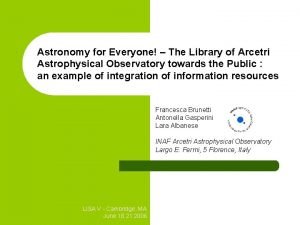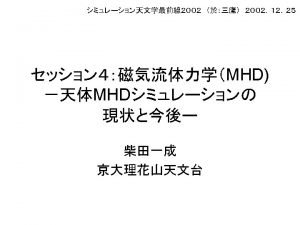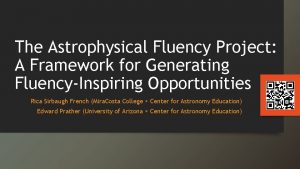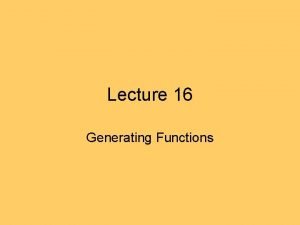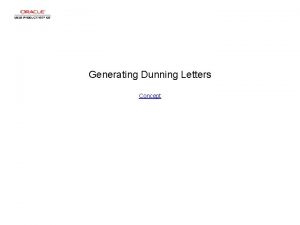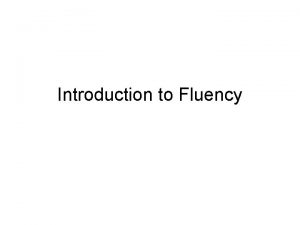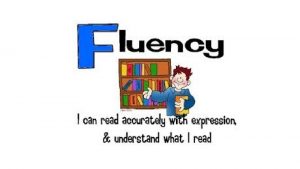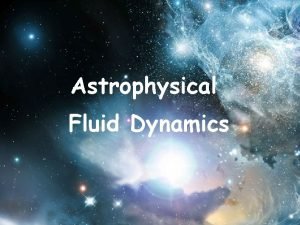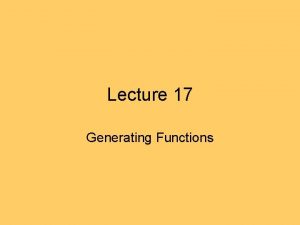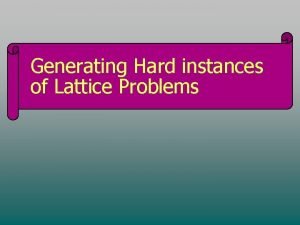The Astrophysical Fluency Project Part II Generating Fluency













- Slides: 13

The Astrophysical Fluency Project Part II: Generating Fluency. Inspiring Opportunities Edward Prather (University of Arizona + Center for Astronomy Education) Rica Sirbaugh French (Mira. Costa College + Center for Astronomy Education) 233 rd meeting of the American Astronomical Society, #417. 03 2019 -01 -10

The Data • 353 multiple-choice questions • used in Think-Pair-Share (TPS) or Peer Instruction (PI) • created by faculty in professional development workshops • Center for Astronomy Education Teaching Excellence Workshops • 41 workshops from 2005 -2015 • 293 questions • AAPT/APS/AAS Workshops for New Faculty in Physics and Astronomy • 4 workshops from 2015 -2017 • 60 questions Earth-Sun-Moon Renaissance Astronomy Solar System Light Stars Exoplanets & Life in the Universe • Galaxies & Cosmology • • •

Representations: ways that information is conveyed 1. words a. b. written spoken 2. pictures & diagrams a. b. c. d. 3. 4. 5. 6. photographs static images figures sketches graphs & charts tables mathematical formalism numbers 7. animations & simulations a. b. moving pictures and/or diagrams with no user interaction simulators with user interaction mechanism(s) 8. recordings of reality a. b. video audio 9. gestures (real-time) a. b. facial expressions body movements

Intellectual Tasks: cognitive exercises the learner engages in 1. 2. 3. 4. 5. 6. 7. 8. visualize draw/sketch model compare identify predict extrapolate count 9. 10. 11. 12. 13. 14. 15. rank sort match quantitative reasoning calculate apply/analyze write

Question Complexity Rubric (QCR): richness of the conversation among learners defending the answer

Research Progression: Initially: develop coding schema to systematically characterize and catalog the diversity of representations and intellectual tasks, and identify levels of complexity, in faculty-generated TPS/PI questions. Progression: recognize a lack of high-complexity questions overall and that some, but not all topics are missing particular representations and/or intellectual tasks Ø Identify variables missing from different topics. Ø Are we even using the representations [and tasks] that offer the right affordances for developing fluency in that topic? Ø Generate new questions to fill gaps. Ø Generate questions that combine representations and tasks in ways not seen in the data.

Theoretical Foundations This method is inspired by the work of Cedric Linder and collaborators 1, 2 on • representations, • ways of conveying information • affordances, • pieces of disciplinary information that a representation allows access to • unpacking, and • disassembling a package of information and making the various pieces and connections explicit • discernment • coming to recognize and understand what to focus on and interpreting it or making meaning using the appropriate context. 1. C. Linder, Eur. J. Sci. and Math. Ed. , 1(2), 43 (2013) 2. J. Airey and C. Linder, J. Res. in Sci. Teach. , 46(1), 27 (2009)

Theoretical Foundations • This theoretical framework asserts that to achieve discipline fluency, learners need to become fluent with a collection of representations 1, 2. • Students will naturally default to the representation(s) most often used rather than those best suited to the task(s) at hand 3. • Since different representations allow access to different types of information and often emphasize different aspects of a concept, it is pedagogically more powerful to use multiple representations than to rely on a single one to do the work of many 4. 1. 2. 3. 4. C. Linder, Eur. J. Sci. and Math. Ed. , 1(2), 43 (2013) J. Airey and C. Linder, J. Res. in Sci. Teach. , 46(1), 27 (2009) T. Fredlund, J. Airey, and C. Linder, Eur. J. Phys. , 33, 657 (2012) T. Fredlund, C. Linder, J. Airey, and A. Linder, Phys. Rev. ST – Phys. Ed. Res. , 10, 020129 (2014)

Fluency-Inspiring Question

Fluency-Inspiring Question Fluency-inspiring questions • require learners to extract information from and transfer it between multiple different representations, • engage learners in multiple intellectually rigorous tasks, and • promote complex discourse to justify an answer.

Fluency-Inspiring Question

Conclusions Immediate implications: use the framework like a tool. • Systematic way to characterize and catalog the representations, tasks, and levels of complexity in multiple-choice TPS/PI questions. • For particular topics, identify gaps in usage of particular representations and tasks. • Generate new questions to fill those gaps. • Generate fluency-inspiring questions Deeper implications: the framework is not simply a tool for making new questions! It is truly generative in that it § informs how we think about our disciplines and § provides pathways for exploring and creating more pedagogically interesting and powerful opportunities ( fluencyinspiring opportunities) opportunities for learners to unpack complex concepts, practice critical discernment, and develop fluency. It is easily extended to other types of instructional materials, methods, and disciplines.

The Astrophysical Fluency Project Part II: Generating Fluency. Inspiring Opportunities Edward Prather (University of Arizona + Center for Astronomy Education) Rica Sirbaugh French (Mira. Costa College + Center for Astronomy Education) 233 rd meeting of the American Astronomical Society, #417. 03 2019 -01 -10
 Arcetri astrophysical observatory
Arcetri astrophysical observatory Astrophysical journal keywords
Astrophysical journal keywords Hát kết hợp bộ gõ cơ thể
Hát kết hợp bộ gõ cơ thể Bổ thể
Bổ thể Tỉ lệ cơ thể trẻ em
Tỉ lệ cơ thể trẻ em Voi kéo gỗ như thế nào
Voi kéo gỗ như thế nào Thang điểm glasgow
Thang điểm glasgow Hát lên người ơi
Hát lên người ơi Các môn thể thao bắt đầu bằng tiếng nhảy
Các môn thể thao bắt đầu bằng tiếng nhảy Thế nào là hệ số cao nhất
Thế nào là hệ số cao nhất Các châu lục và đại dương trên thế giới
Các châu lục và đại dương trên thế giới Công thức tính thế năng
Công thức tính thế năng Trời xanh đây là của chúng ta thể thơ
Trời xanh đây là của chúng ta thể thơ
